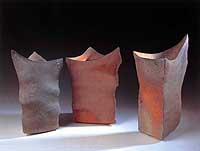|
Remaking form, recapturing spirit
By ROBERT YELLIN
for The Japan Times, April 10, 2002
Hand grenades, gas burners and patio furniture are not items usually associated with ancient potting centers, yet in Shigaraki, southern Shiga Prefecture, even these odd items have been fired.
|

|
|
|
|
The works of Shigaraki potter Yasuhisa Kohyama include striking triangular works (top)
and Kamo-dokkuri sake flasks,
all fired in an anagama.
PHOTOS COURTESY OF YASUHISA KOHYAMA
|
|
|
The Shigaraki staple most folks are familiar with, though, is the pudgy tanuki that stands in front of drinking establishments throughout Japan. It holds a sake flask in one hand and in the other, a promissory note for the booze; it never pays, though. If you've ever been to Shigaraki, you cannot miss the numbing variety of garish tanuki that stand in front of many tourist shops.
Tanuki are synonymous with modern-day Shigaraki, just as room-heating hibachi were during the postwar period. But there is so much more to this ancient potting center, first established in the Kamakura Period (1185-1333), than this folksy novelty.
Shigaraki enjoyed its glory years in the Muromachi and Momoyama periods. However, as happened to many yakishime (unglazed high-fired stoneware) ceramic traditions, the natural beauty of the wares faded in the Edo Period -- and even more so in the Meiji Era -- due to changing technologies and a lack of interest.
It wasn't until the late 1960s that a revival of the ancient ways rekindled Shigaraki's true ceramic traditions. One pioneer reawakening the energy and spirit of ancient Shigaraki is Yasuhisa Kohyama. He's having a long-overdue exhibition in Tokyo, which starts today and runs till April 16, 2002, at the sixth-floor gallery of Takashimaya, Nihonbashi.
When looking at the first products of Shigaraki, such as a 14th-century cinerary urn, one cannot help but appreciate the natural form and beauty of the unglazed clay. These qualities continue into works dating from the Muromachi and Momoyama periods, such as the famed large tsubo (tall jars) that have found their way into museums throughout the world.
Kohyama draws inspiration from these works and other ancient Japanese wares, like those of the Jomon Period (ca. 8,000 B.C.-300 B.C.). He does so in a vital and energetic way, creating original sculptured forms that pay homage to his ceramic roots without being carbon copies of them.
Take, for instance, his triangular works with sharp wavy edges. These have no decoration, only the warmth of their own muted orange clay. This allows the form of each to "speak," as if in a bold whisper. These works lack the ornate decoration of their distant Jomon cousins, fired 10,000 years ago, yet share something of the same verve and temperament. This also goes for Kohyama's gray, vertical pieces that hark back to the fifth-12th century sueki wares -- the first Japanese pots fired in an anagama (a single-chambered tunnel kiln). Introduced via Korea, the anagama reshaped the Japanese ceramic scene.
Kohyama revolutionized Shigaraki in his own way when he became the first potter since medieval times to build an anagama. That was in 1968 and Kohyama was against the trend of the times: Japan was looking forward even as the potter was casting back centuries. The Tokyo exhibition of works from the first firing of the anagama caused quite a stir, with famous potters such as Shoji Hamada coming to see what the buzz was all about. Collectors and museums snapped up pieces; Kohyama's work is in the permanent collections of New York's Metropolitan and Brooklyn museums, as well as many other institutions.
All the works in the current exhibition were fired for seven days in (naturally) an anagama; temperatures reached just over 1,300 degrees in the front of the kiln. The white, gritty, feldspar-flecked Shigaraki clay metamorphoses to sunset orange upon first firing. Kohyama fires many of his works twice or three times, and this produces a grayish buildup of ash that is reminiscent of those early sueki wares. Dripping ash glazes, like those seen on more standard Shigaraki wares, would interfere with the grandeur of the potter's forms.
And form is the aspect of Kohyama's work that most impresses the viewer. Some pieces are curled up slabs with an "inner sanctum." Others are broad expanses with wavy sides where their creator sliced them like a wedge of cheese. In these pieces we can see the radiance of Shigaraki clay: one side pitted with quartz stones, the other face matte, sharkskin-textured. A few do balancing acts, looking as if they might topple over at any time; others resemble clay wings, in which we can "feel" the wind.
His sake flasks are in a kamo-dokkuri (duck form), although they actually look more like turtles. They also make the most fabulous "tok-tok-tok" sound when sake is poured from them, and as any sake vessel connoisseur knows, such an accent is of utmost importance.
Of the 60 or so works shown, all (with the exception of the sake vessels) are sculptural. For a Shigaraki potter, that alone would be novel. This being Kohyama, though, we're in a realm beyond mere curiosity. This exhibition is the closest you'll come to finding spirit in form since the first Jomon potters touched clay.
The Japan Times: April 10, 2002
(C) All rights reserved
For more on this artist, please click here (lots of photos).
|